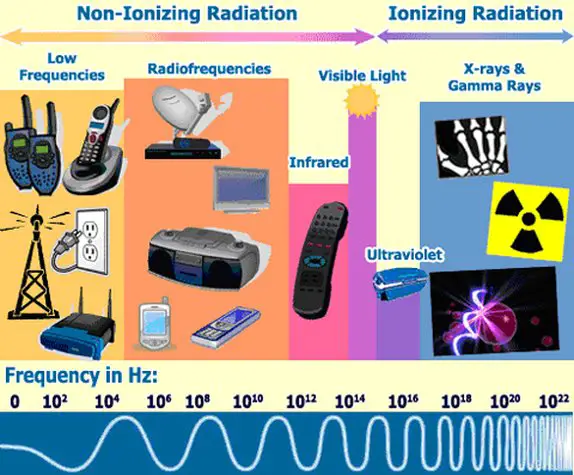Radiation is used in a range of industrial, medical, and communication technologies. Although these have beneficial applications, radiation exposure can be harmful to human health. Some sources of radiation are so common and ordinary that few of us even realize we’re surrounded by them. In this article, we’ll go over some of these and address safety concerns related to them.
Also Read: E-Books: PPE for Chemical, Biological, and Radiological Hazards free

What Is Radiation?
The Department of Labor defines radiation as energy travelling through space. There are two main types of radiation:
- Non-ionizing radiation consists of optical radiation (ultraviolet, visible, and infrared) and electromagnetic fields (power frequencies, microwaves, and radio frequencies)
- Ionizing radiation occurs as either electromagnetic rays (x-rays and gamma rays) or particles (alpha and beta particles)
know more about Ionizing Radiations Quantities and unites
Measurement and Exposure Limits
Radiation is measured in rem. The millirem (mrem) is the unit used to measure the effect of radiation on the body. The mrem also takes into account the differences in the various types of radiation.
According to the Environmental Protection Agency (EPA), man-made sources of radiation should not exceed four mrem per year. For individuals working around radiation full time, males 18 years and over should not be exposed to more than five rem per year; and pregnant women should not be exposed to more than 500 mrem during pregnancy.
Effects of Radiation Exposure on Human Health
The nature and extent of the effects of radiation on the human body depend on the exposure levels, the frequency of exposure, and the penetrating power of the radiation.
Radiation has two types of effects:
- Deterministic effects occur at the organ level. If a sufficient number of cells become affected, the organ is not able to function and becomes impaired. Further, the effects of the radiation are not noticeable until the absorbed dose is greater the threshold level. Therefore, deterministic effects are manifested soon after exposure and include: radiation skin burning, blood count effects, and cataracts
- Stochastic effects occur at the cellular level. They are caused by more subtle radiation-induced cellular changes, such as DNA mutations. For these effects to occur, radiation exposure must be random in nature with no threshold dose. Cancer is the only observed clinical manifestation of radiation-induced stochastic effects
9 Common Sources of Radiation in the Home and Workplace
1. Television Sets
Watching 4.5 hours of television per day exposes the viewer to one mrem of x-ray radiation. Television sets that contain cathode ray tubes can generate low-level x-rays.
2. Computer Monitors
Computer monitors that contain cathode ray tubes also generate low-level x-rays.
3. Drinking Water
Water can pick up radiation from natural sources, such as rocks and soil. In urban areas, radiation comes from rivers and lakes, while in rural areas it comes from wells. The average person can acquire up to five mrem of radiation from drinking water per year.
4. Natural Gas
Natural gas used for cooking and heating can increase your radiation exposure by 9 mrem per year.
5. Cellphones
Cellphones give off radio frequency waves, exposing the average user to 11 mrem of radiation per year. Fortunately, these radio frequency waves are at low enough levels not to cause damage to cells or tissues.
6. Microwave Ovens
Microwave ovens emit radio frequency electromagnetic energy. Some studies have indicated that microwave energy may leak from your microwave while in use, but it will not have any negative health impacts if it is properly maintained.
7. Soils
Radioactive particles are present in soil due to cosmic radiation in the Earth’s crust or from man-made releases such as nuclear power plant disasters. These particles are then released in the form of gases which we either inhale or take in through water or plants. The average person acquires 35 mrem of radiation per year from soils.
8. Radon Gas
Radon is the second-leading cause of lung cancer in the United States. It is emitted from the radioactive decay of natural uranium in the ground. It is also found in some construction materials. The average person may be exposed to up to 200 mrem of radiation per year from building materials containing radon. explore more about Risk of Radon Gas
9. Cigarette Smoke
Smokers not only increase their risk of lung cancer and heart disease; they also increase their exposure to radiation. It’s estimated that the average smoker is exposed to 1,300 rmem of radiation per year from radioactive material in the fertilizers used to grow tobacco plants, as well as other natural sources.
General Safety Tips to Avoid or Reduce Radiation Exposure
- Consider switching to flat screen television sets and computer monitors. These do not contain cathode ray tubes and, therefore, do not produce x-ray radiation.
- Opt for bottled water over tap water. While both may contain radiation, the levels of radiation in bottled water are far lower.
- Although radiation levels from cellphones are extremely low, to reduce radio frequency waves near your body you can either get a hands-free headset which connects directly to your phone or use speaker-phone more often.
- Keep your exposure to microwave energy at a minimum by keeping your microwave oven in good working condition.
- You cannot see or smell radon, but it’s not difficult to determine if you have a radon problem in your home or workplace. All you need to do is test for radon using any low-cost do-it-yourself radon testing kit found at any hardware store.
- Quitting smoking eliminates all the exposure you get from cigarettes.
The Importance of Radiation Safety
Radiation is invisible and odorless. That makes it easy to become complacent about the risks associated with it. The simplest solution is to implement and follow radiation best practices in order to build routines and habits that reduce our radiation exposure.( Also Read: E-Books: Radiation Protection and Safety in Industrial Radiography)
Read more about everything you need to know about Radiation at EMF Empowerment.



